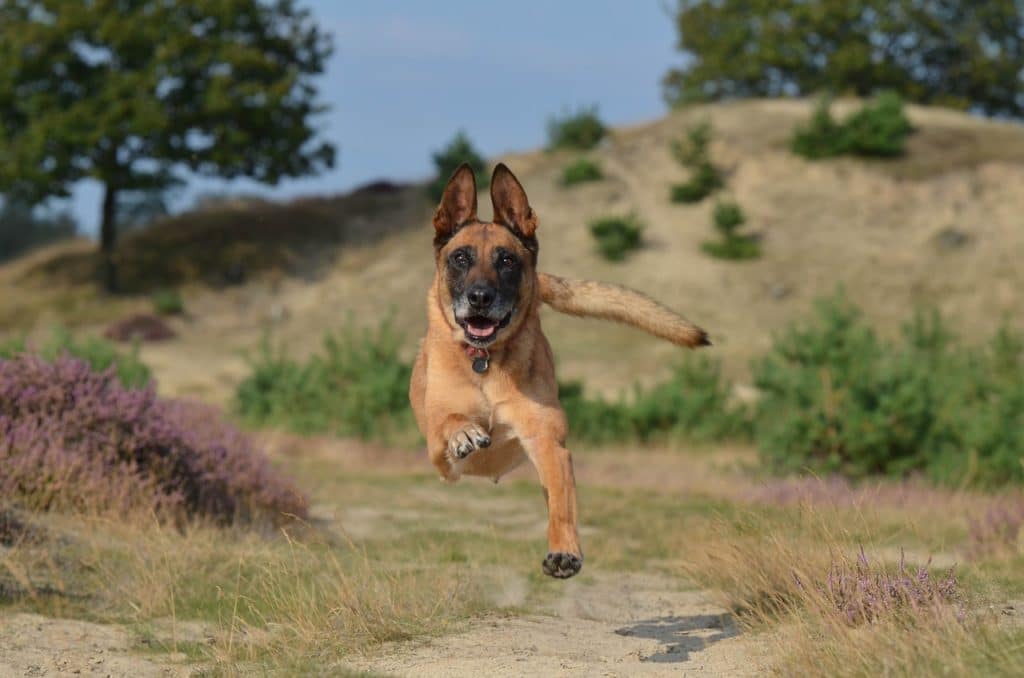12 Natural Ways to Relieve Your Dogs Joint Pain
Quick Guide
A shocking 1 in 4 dogs in the US are diagnosed with arthritis. But unfortunately those odds are only getting worse for our canine friends. This degenerative joint disease is more widespread in older dogs as joints deteriorate with age, but it’s also seen in younger dogs due to injury or bone development issues.
Arthritis is the most common form of joint pain veterinarians diagnose. The disease strikes as your dog’s cartilage and ligaments gradually degrade. This causes the bones to rub against each other and become inflamed. It can make moving extremely painful for your dog, and as a devoted pet parent you no doubt want to help your dog feel as comfortable as possible.
However, to relieve pain and inflammation, veterinarians often prescribe non-steroidal anti-inflammatory drugs (NSAIDs). But these medications can cause digestive issues, liver damage and can even break down cartilage making the arthritis worse.
Related:
Steroids are another medication vets prescribe, but these drugs should only be used on a short-term basis to avoid the many side effects they can cause. Some of the known side effects of steroid use include weight gain, fluid retention, increased risk of heart disease, diabetes, gastrointestinal bleeding and ulcers.
So it begs the question: is there a safer way to treat arthritis and joint pain in our dogs? Fortunately, there are natural solutions that can help both reduce inflammation and relieve pain without any further risks to your dog’s health. Here’s our guide to help you relieve your dog’s pain naturally.
Natural anti-inflammatories
Some vegetables, herbs and spices are natural anti-inflammatories and can help reduce painful swelling. But before making any drastic changes to your dog’s diet, you should always consult your veterinarian first. Your vet will advise you on the best foods for your specific dog and the kind of quantities you should use.
Comfrey is one of the top anti-inflammatory and pain-relieving herbs and has been used to treat a wide range of health issues in dogs and humans for many years. Experts recommend ½ to one teaspoon of dried comfrey for each pound of food.
Ginger is renowned for easing digestive discomfort and nausea, but it can also be used to relieve arthritic pain. This incredible spice prevents the immune system from producing leukotrienes, the active molecules that cause inflammation. The crushed root can be mixed into your dog’s food each day. You can use a ¼ teaspoon for small breeds, ½ a teaspoon for medium breeds and ¾ teaspoon for large dogs.
A few other natural anti-inflammatories and pain-relieving foods include alfalfa, turmeric, cayenne, celery and papaya.
Joint support supplements
A study in 2014 recorded the benefits of using certain supplements, both for relieving joint pain in dogs, and helping the joint repair itself over time. Of the 32 dogs involved in the study, the results revealed significant improvements in the dogs that took supplements, against the dogs taking a placebo. For the dogs on supplements, their daily activity increased from six to eight hours, while the dogs taking a placebo became progressively less active. None of the dogs saw their health decline while taking supplements, whilst 35.8% of the dogs taking the placebo showed deterioration.
The most effective supplements for joint pain and inflammation include ingredients like Glucosamine, Chondroitin, Boswellia and Omega 3 fatty acid. You can now buy purpose-built joint support supplements which include these ingredients and other repairing and anti-inflammatory aids.
It’s always a good idea to consult your vet before buying a supplement for your dog. Your vet will have recommendations for those with the best quality ingredients, and suggest the best supplement for your dog’s individual condition.
Orthopedic dog bed
An unsupportive, lumpy dog bed can further aggravate your dog’s aching joints. Sleep can be difficult when your dog is constantly in pain, and bed rest is important to help them recuperate. An orthopedic bed is designed for dogs with joint problems and will provide the support your dog needs to manage their pain.
Most orthopedic dog beds are made with memory foam. The material will mold to the shape of your dog’s body without adding pressure to sore joints. Your dog will get a comfortable night’s rest and it could make all the difference to their quality of life.
But make sure you do your research and look for great reviews before you buy. It can be a large expense for a dog bed, and not all are suitable for dogs with arthritis – even when they’re advertised as such! If you’re ever in doubt, ask your veterinarian for recommendations.
Make walking easier
If you can make it easier for your dog to walk, you’ll help them feel less pain and keep them active. That means keeping nails trimmed to avoid placing unnecessary pressure on your dog’s joints. Your dog’s nails should only just touch the ground. If you don’t feel comfortable trimming your dog’s nails yourself, a groomer or vet will happily clip them for you.
If your home has slippery or hard floors, think about putting rugs or runways down to stop your dog slipping. If you often find your dog slips at home, this can jerk joints uncomfortably and cause pain.
Another option for gaining grip on hard floors is friction socks. They have a rubber coating on the sole of the sock giving your dog better traction on slippery surfaces. Not all dogs will tolerate having socks on their paws. If your dog seems anxious or stressed about having them on, using rugs or installing carpet in your home may be your best option.
Stay active
It may seem counterintuitive, but staying active is one of the best things you can do for your dog’s joint pain. Joints and muscles can become stiff if they’re not used regularly. Exercise will help keep those muscles strong and provide stability around the joints, as well as improve circulation to problem areas.
But instead of taking your dog for a run or an hour-long walk, perform light exercise more frequently. Intense workouts in one go can cause stress and injury to delicate joints. Provide four to five 15-minute walks around the block throughout the day and a couple of short, gentle play sessions on carpet indoors. Be sure to avoid exercises that involve high impact activities such as running or jumping.
Always consult your vet before introducing a new exercise regime.
CBD treatments
Humans have been using cannabinoid (CBD) treatments to relieve pain and inflammation from arthritis for many years. But in more recent years, studies have suggested CBD can provide that same relief and slow down the degeneration process in dogs too.
CBD is the substance found in the cannabis plant. It’s the THC in the cannabis plant that creates the ‘high’ people report, but CBD itself is a non-psychoactive. It provides all the calming and pain-relieving benefits without any toxic effects.
Both humans and dogs have the same endogenous cannabinoid system, and our dogs respond to CBD in the same way we do. CBD targets the receptors in your dog’s brain, central nervous system, organs and immune cells that stimulate relaxing, pain-relieving and anti-inflammatory effects.
CBD therapy can come in the form of CBD oil, capsules and CBD-infused treats. Because CBD is non-toxic with no significant side effects, you don’t have to worry about overdosing your dog. But it’s always a good idea to follow the product recommendations to understand how your dog responds to the new treatment.
Maintain a healthy weight
It can be difficult to control your dog’s weight when the pain prevents your dog from being as active as they once were. Which is another reason why it’s important to maintain a new exercise regime with regular bouts of low intensity activity. If your dog is overweight, this can put extra strain on their joints. By maintaining a healthy weight you’ll reduce the load on your dog’s joints and reduce their pain.
If your dog is already a healthy weight, try to maintain it with a quality, healthy diet. Consider switching to a dog food with added nutrients that’s designed for dogs with arthritis. These prescription diets will already contain many of the anti-inflammatory ingredients mentioned above. With a clinically proven combination of ingredients, many products claim they’ll help improve your dog’s ability to walk, run and jump in as little as 21 days.
There’s a simple way to check if your dog is overweight. Run your hands along your dog’s ribs. If you can’t just about feel them, your dog could do with losing a few pounds. You should also be able to see a waist when looking at your dog from overhead. If they’re more barrel-shaped, it’s time to think about reducing their calorie intake.
Consult your vet about switching your dog to a prescription low-fat, low-calorie diet paired with gentle exercise. This will get the weight off and do wonders for helping your dog feel more comfortable when mobile.
Hydrotherapy
Hydrotherapy is a great way to keep your dog moving without impacting painful joints. Specialist centers generally use two types of hydrotherapy for treating arthritic dogs – an underwater treadmill and full immersion swimming. With water treadmill treatment, your dog benefits from the buoyancy support of water and the water’s resistance without putting strain on joints. While full immersion involves your dog swimming freely in a pool with the support of a therapist.
Since the pools are warmed to between 90-100F this further helps reduce stiffness and joint inflammation. Your dog is able to stretch out their muscles and joints freely without their weight causing bone friction and pain. The water resistance is also excellent for building muscle around your dog’s affected joints to provide better support long-term.
Heat therapy
Applying heat to your dog’s painful joints can reduce stiffness, inflammation and swelling, relieve pain and increase blood flow. Heat therapy can be used on any part of your dog’s body where spasms, muscle damage and joint strain occur.
You should always consult your vet before trying heat therapy on your dog. Because if your dog has just suffered a joint injury and the problem isn’t chronic arthritis, experts advise using cold therapy for the first 72 hours before applying heat therapy. It’s important you’re giving the right treatment for your dog’s specific ailments.
If heat therapy is recommended, there are a number of options you can try such as heated blankets, heated beds and heat pads. You can also buy body wraps that can be strapped directly onto your dog’s exact pain points.
If you’re thinking about trying a shop-bought heating device, always follow the instructions carefully to avoid burning your dog’s skin. The heating device should never be hot to touch, only warm. To be sure it’s the right temperature, hold it against your own skin for 30 seconds before applying to your dog.
You can even make your own heat pack at home with a sock and uncooked rice. Fill a sock with uncooked rice and tie it closed. Pop it in the microwave for 60 seconds or until it reaches your desired temperature. Give the pack a shake to distribute the heat evenly and wrap it in a thin towel to avoid burning your dog’s skin. Test it’s not too hot and apply the pack to your dog’s problem areas for around 15 minutes.
If your dog shows any signs of discomfort, remove the heat source immediately and consult your vet.
Laser Therapy
Laser therapy is a non-invasive treatment that is proven to control pain and improve mobility in arthritic dogs. The light of the laser delivers photonic energy which increases the production of cell fuel, reduces pain and inflammation and increases circulation to injured areas. Dogs and their owners have seen remarkable results when the treatment is combined with physical therapy and a healthy nutrient-rich diet.
Depending on the size of the area needing treatment, a typical session can last anywhere from five to 20 minutes. The good thing about laser therapy is there’s no need to shave the area before treatment and your dog will not need to be sedated. Your dog will be given a full physical exam beforehand, and the number of sessions recommended will depend on the severity of your dog’s problems. But you may expect to start off with two or three sessions a week which will gradually decrease as your dog starts to show signs of improvement.
Acupuncture
Acupuncture is more commonly recognized for treating a range of bone and muscle complaints in humans, but many veterinarians now turn to needle therapy to help their canine patients too. There will always be skeptics of this alternative therapy, but many dog owners have reported promising results in relieving their dog’s joint pain.
The therapy encourages the release of natural anti-inflammatory and pain-relieving hormones. It’s said to relax your dog’s muscles and improve oxygen flow to the tissues, both of which reduces pain and improves mobility. The treatment also reduces the level of cortisol in your dog’s body, which is the substance that controls stress responses.
Although acupuncture dates back thousands of years in Chinese medicine, it’s become an increasingly popular therapy option for our pets across the world. It’s crucially important you seek help from a qualified acupuncture therapist who understands canine anatomy. And is also a qualified practitioner in traditional Chinese veterinary medicine. This will ensure your dog has the best chance of getting pain relief from their sessions.
During the session, the therapist will insert thin needles into pressure points near inflamed areas. According to veterinarians, most dogs don’t notice when the needles are inserted and each session can last 30-60 minutes.
Massage therapy
We all know that sense of relief you feel when aching muscles and sore joints are massaged. Massage therapy provides a whole host of benefits for dogs suffering with joint pain too. Including preventing adhesions of muscles, tendons and ligaments; reducing joint stiffness, swelling and muscles spasms; improving blood flow, muscle flexibility and tissue relaxation; as well as decreasing pain while maintaining muscle mass.
Consider using a certified animal massage therapist to treat your dog. Massage therapy is something you can also learn and do at home. And if you’d rather massage your dog at home, it’s a good idea to go to a professional session once or twice so you can learn the technique for yourself. The first session may be longer (up to an hour) to allow the therapist to stretch your dog’s limbs and really work on those tight and tender areas. Then while at home, you can massage your dog in 10-20 minute sessions once or twice a day.
You should only ever perform a light pressure massage on your dog. A deep tissue or intensive massage should be performed by a qualified canine massage therapist to prevent further damage. When you massage regularly, you’ll notice your dog starts to relax and enjoy the sensation. It’ll not only relieve your dog’s pain and increase their mobility, but it’s a great bonding session for you and your dog and a calming experience they can look forward to.















